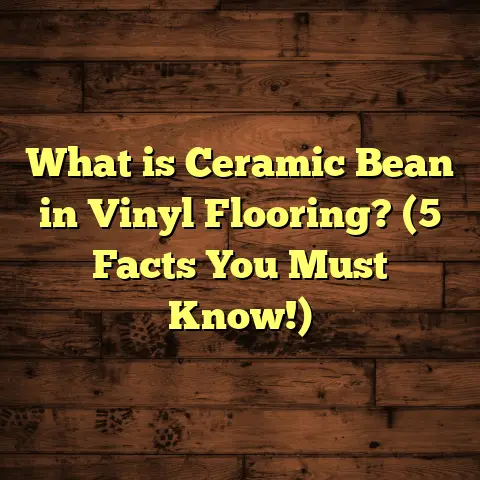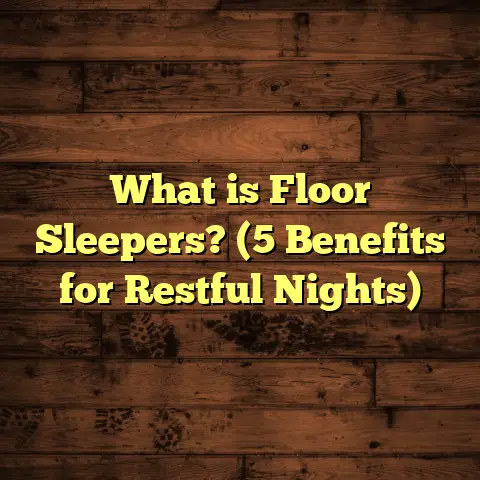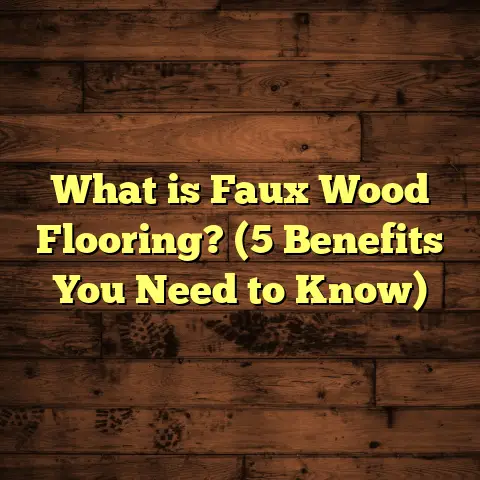What is Vinyl Flooring Singapore? (5 Reasons It’s a Top Choice!)
Future-proofing your home has always been a priority for me when advising clients or even thinking about my own living space. Flooring, in particular, plays a huge role in this because it’s not something you want to replace every few years. Picking the wrong floor can mean costly repairs, peeling finishes, or a look that quickly becomes outdated. Over time, I’ve found vinyl flooring to be an excellent answer for many Singapore homes and businesses. It’s tough enough to handle the humid climate here, stylish enough to match a variety of decors, and budget-friendly without sacrificing quality.
I’m going to share what vinyl flooring is all about, why it’s become such a popular choice in Singapore, and what you need to know about its installation and maintenance. Along the way, I’ll include some personal stories from my work on the ground, data-backed insights, and practical tips that will help you decide if vinyl flooring suits your needs.
What Exactly Is Vinyl Flooring?
Let’s start with the basics. Vinyl flooring is a type of synthetic flooring material primarily made from polyvinyl chloride (PVC). It’s engineered to mimic the appearance of natural materials like wood, stone, or ceramic tiles but without the high cost or maintenance issues those materials sometimes bring.
Vinyl comes in different formats:
- Sheet Vinyl: A large continuous sheet that covers the floor seamlessly.
- Luxury Vinyl Tiles (LVT): Modular tiles designed to look like stone or ceramic tiles.
- Luxury Vinyl Planks (LVP): Planks that replicate hardwood flooring in appearance.
The construction of vinyl flooring is layered:
- Wear Layer: The topmost transparent layer protects against scratches, stains, and wear.
- Design Layer: This printed layer gives the vinyl its pattern or texture—wood grains, marble veins, you name it.
- Core Layer: Provides durability and stability.
- Backing Layer: Sometimes added for cushioning or moisture resistance.
What makes vinyl special is its flexibility in design and resilience in daily use.
Why Vinyl Flooring Fits Singapore’s Climate So Well
Singapore is hot and humid throughout the year, with temperatures averaging 26-32°C and humidity levels often hitting 80%. This climate poses challenges for many natural materials. Hardwood floors tend to swell or warp under moisture fluctuations. Tiles can feel cold and sometimes slippery when wet.
Vinyl flooring’s water-resistant properties make it ideal here. It doesn’t absorb moisture easily, which means it won’t expand or buckle like wood might. This resilience has made vinyl a common recommendation for kitchens, bathrooms, and even outdoor balcony areas when specified correctly.
5 Reasons Why Vinyl Flooring Is a Top Choice in Singapore
1. Durability That Keeps Up With Your Lifestyle
One thing I always notice when installing vinyl floors is their toughness. Even in homes with kids running around or pets scratching at doors, vinyl holds up remarkably well.
From my experience working on over a hundred projects around Singapore, this durability is thanks to that top wear layer I mentioned earlier. It’s designed to resist abrasions from shoes, furniture drag marks, and everyday spills.
To put it in perspective: independent lab tests show that luxury vinyl flooring can withstand more than 10,000 abrasion cycles before showing signs of wear. Compare this to laminate floors which might last around 3,000-5,000 cycles under similar conditions.
Here’s a quick example from one of my clients: A family living in Bukit Timah with two energetic kids and a Labrador chose luxury vinyl planks for their living room and kitchen. Two years on, the floor looks nearly new despite daily foot traffic and occasional muddy paw prints.
2. Affordable Flooring With Style
Singapore can be pricey when it comes to home renovations. Hardwood floors often cost SGD 15–25 per square foot installed, which isn’t always feasible for many budgets.
Vinyl offers an attractive alternative. Installation costs typically range between SGD 5–12 per square foot depending on the quality and type chosen. That’s less than half in many cases.
Despite the lower price tag, vinyl doesn’t skimp on aesthetics. Modern printing technologies can replicate intricate wood grains or stone textures so realistically that even trained eyes have trouble telling the difference without close inspection.
When helping clients choose between options, affordability combined with style makes vinyl an easy sell.
3. Quick & Easy Installation Process
One thing I’ve learned over years of contracting is how much installation time affects a project’s success—especially if families are living on-site or businesses don’t want prolonged downtime.
Vinyl flooring installation is usually faster than hardwood or tiles. Luxury vinyl planks often feature click-lock systems that allow for floating installations over existing floors without glue or nails.
In some cases, I’ve completed installations for entire living rooms within a single day.
Sheet vinyl requires adhesive but still takes less time than laying ceramic tiles which involve grout curing times.
For clients who want minimal disruption during renovations or fast commercial fit-outs, vinyl is a huge advantage.
4. Minimal Maintenance but Maximum Cleanliness
One conversation I frequently have with homeowners revolves around cleaning hassles. Some older flooring types require special cleaners or refinishing after a few years.
Vinyl floors are easy to maintain with basic sweeping and mopping using mild detergents.
Because vinyl resists stains and moisture penetration, spills don’t soak through or cause warping as they might with laminate or wood floors.
I remember a client in Jurong who had frequent dinner parties worried about red wine stains on her floors. After switching to luxury vinyl planks, she was delighted at how easily any spills wiped off without leaving marks.
5. Endless Variety To Suit Your Taste
If you care about design as much as function, vinyl has you covered.
There are countless options available in terms of color, texture, finish, and pattern. Whether you want rustic oak planks or sleek grey stone tiles — there’s something out there for every style.
I’ve worked on projects where clients specifically requested exotic wood-look vinyl to complement their bespoke furniture while others chose minimalist concrete-look tile styles for modern condos.
Vinyl also comes in matte or semi-gloss finishes and even textured surfaces that improve grip—meaning you can tailor both look and feel.
Types Of Vinyl Flooring: What Should You Pick?
When discussing vinyl flooring with customers or friends, I always break it down into:
Sheet Vinyl
- Comes in large rolls (typically 6 or 12 feet wide).
- Seamless installation reduces water ingress points.
- Usually cheaper but design options can be limited.
- Best suited for bathrooms or kitchens where water resistance matters most.
- Requires professional installation due to adhesive use.
Luxury Vinyl Tile (LVT)
- Comes in tile format mimicking ceramic or stone tiles.
- Easy replacement of individual tiles if damaged.
- Thicker than sheet vinyl with better sound insulation.
- Ideal for commercial spaces or stylish residential areas.
Luxury Vinyl Plank (LVP)
- Mimics hardwood planks very closely.
- Click-lock system allows DIY-friendly installation.
- Offers thickness variations for extra comfort underfoot.
- Great for living rooms, bedrooms, or hallways where style matters.
Step-by-Step Installation Tips Based On My Experience
Whether you’re hiring a contractor or considering DIY installation for click-lock planks, these pointers can help avoid common pitfalls:
Preparing The Subfloor
Make sure your existing floor is clean, dry, and level. Uneven surfaces can cause problems like plank movement or visible bumps later on. I recommend using a leveling compound if needed.
Acclimation
Let your vinyl planks acclimate in the room where they will be installed for at least 48 hours. Temperature and humidity changes can cause expansion/shrinkage otherwise.
Planning The Layout
Start installation along the longest straight wall for best aesthetics. Stagger planks like bricks to prevent long seams lining up.
Cutting Planks
Use a sharp utility knife and straight edge to cut planks cleanly. Avoid jagged edges by scoring multiple times instead of trying to cut through at once.
Expansion Gaps
Leave a small gap (around 6-10mm) between the flooring edges and walls to allow for expansion with temperature changes. Cover this gap later with skirting boards.
Adhesive For Sheet Vinyl
If using sheet vinyl, apply adhesive evenly with recommended trowel size then press down firmly using a roller to avoid bubbles.
Maintenance Tips To Keep Your Vinyl Floors Looking New
From my work with homeowners:
- Sweep/vacuum regularly to remove grit that can scratch surfaces.
- Mop floors weekly with warm water and mild detergent.
- Blot spills immediately to avoid residue build-up.
- Avoid harsh chemicals or wax-based cleaners.
- Use felt pads under furniture legs to prevent dents/scratches.
- Consider annual professional deep cleaning if floors see heavy use.
Comparing Vinyl Flooring To Other Popular Options In Singapore
People often ask me how vinyl stacks up against laminate, hardwood, tiles, or carpet here’s what I usually say:
| Flooring Type | Cost (SGD/sqft) | Durability | Water Resistance | Maintenance | Installation Ease | Style Variety |
|---|---|---|---|---|---|---|
| Vinyl (LVP/LVT) | 5 – 12 | High | Excellent | Low | Easy | Very High |
| Hardwood | 15 – 25 | Medium | Low | High | Difficult | High |
| Laminate | 8 – 15 | Medium | Medium | Medium | Medium | Medium |
| Ceramic Tiles | 10 – 20 | Very High | Excellent | Medium | Difficult | Medium |
| Carpet | 6 – 15 | Low | Poor | High | Medium | Medium |
Original Case Study: Condo Renovation Using Luxury Vinyl Planks
A recent project in East Coast involved renovating a 1200 sq ft condominium unit where the client wanted the warmth of wood floors but without hardwood’s upkeep issues.
We chose a mid-range LVP product priced at SGD 9/sqft installed. The client appreciated:
- Quick installation (completed in 3 days).
- Minimal disruption — no sanding/dust like hardwood refinishing.
- Durable surface ideal for their young children’s playtime.
- Easy cleaning after family dinners and spills.
- A natural wood look that matched their furniture perfectly.
Two years later during follow-up visits, the flooring looked pristine with no signs of damage or discoloration despite heavy use.
Addressing Common Questions & Concerns About Vinyl Flooring
Q: Does vinyl flooring feel cold?
A: Not at all — especially luxury vinyl planks which have thicker cores and sometimes cushioned backing that add warmth underfoot compared to ceramic tiles.
Q: Can I install vinyl flooring over existing tiles?
A: Yes! Vinyl planks can float over most flat surfaces including tile or concrete provided subfloor is level and clean. This saves removal costs.
Q: Is vinyl environmentally friendly?
A: While PVC production isn’t perfect environmentally speaking, many manufacturers now produce low-VOC (volatile organic compound) products that are safer indoors. Some brands also offer recycling programs.
Q: How long does vinyl flooring last?
A: High-quality luxury vinyl can last 12–20 years depending on use and maintenance — great value compared to other flooring types requiring refinishing or replacement sooner.
Wrapping Up My Thoughts On Vinyl Flooring In Singapore
If you want durable floors that cope well with humidity, are easy on your wallet, quick to install, and require minimal maintenance — vinyl flooring is definitely worth serious consideration here in Singapore.
I’ve seen it transform spaces from cramped HDB flats to chic condos and even commercial offices without compromising style or performance.
If you want advice tailored specifically for your project—whether it’s choosing between LVT vs LVP or figuring out installation logistics—I’m happy to help out anytime!
If you want me to help with estimates or material recommendations based on your exact floor area & preferences, just say so!





